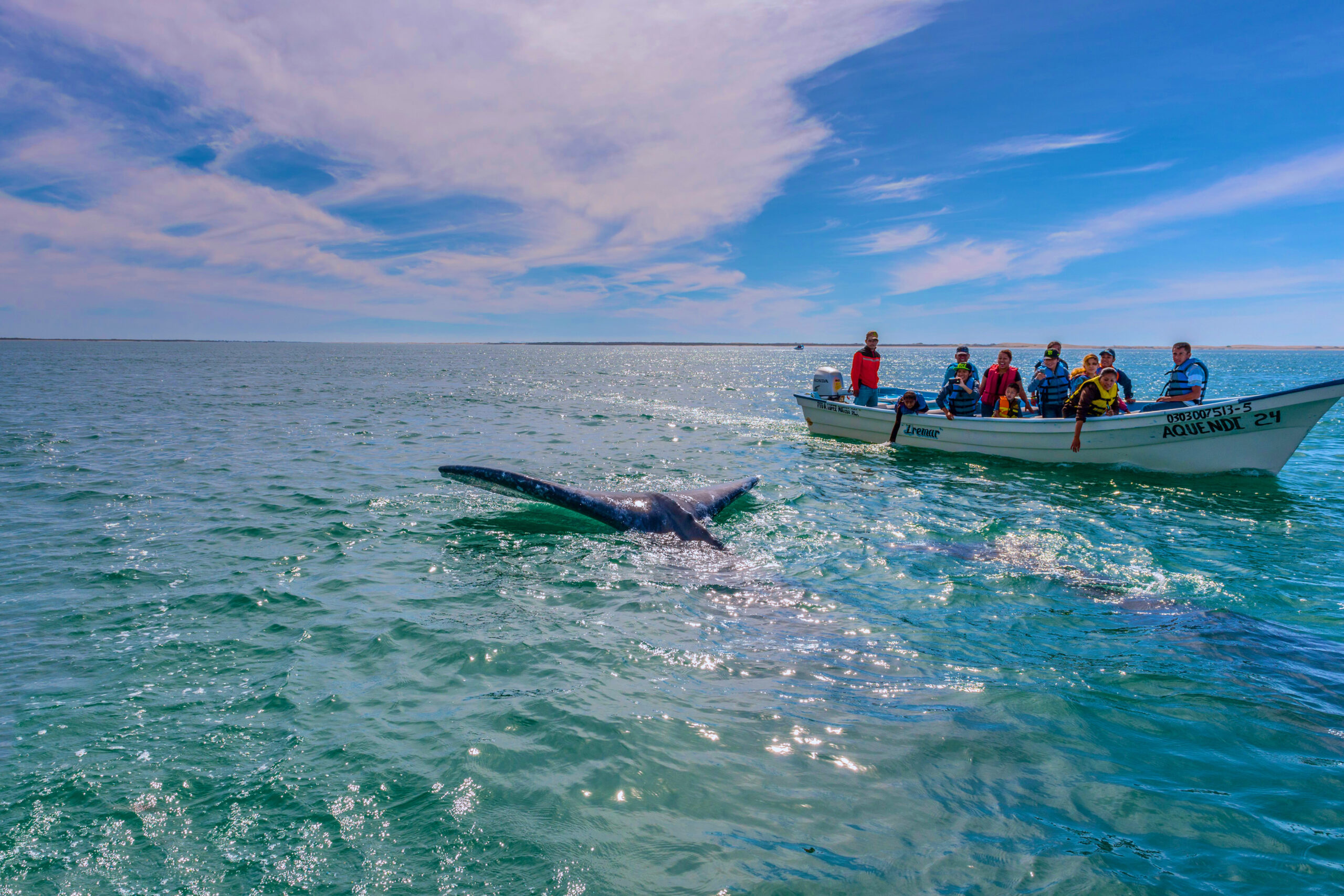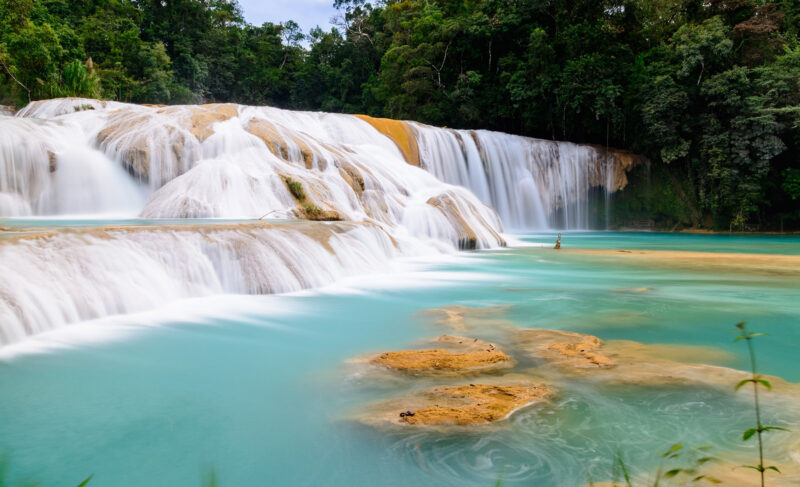On the calm waters of the Sea of Cortez, also known as the Gulf of California, our panga boat skims across the surface of the sea on a cool January day. All eyes scan the water, looking for that first spray, which signals a whale is nearby, exhaling on the water’s surface. In this case, the whale we’re seeking is a blue whale, the largest animal in the world, which visits this narrow strip of sea in Loreto, Baja California Sur for feeding and mating during this time of the year. These gentle giants love the warm, nutrient-dense waters of the Sea of Cortez, where they eat up to 4 tons of krill per day. Blue whales can reach up to 110 feet long, weigh more than 330,000 pounds, and have a heart the size of a small car. Of course, whale watching is always special, but there’s something extra thrilling about checking off a sighting of the world’s largest animal.

Near a sea cliff, our captain cuts the engine and our search begins. The panga bobs side to side, the only sound a hollow thumping as water laps against the hull. We watch and wait, ears and eyes ready for anything: a splash, a breath, an air bubble, anything. Pulling my jacket closed in the wind, I’m reminded of the fictional Captain Ahab from Herman Melville’s Moby-Dick. Except this search is not a vengeful quest on an elusive white sperm whale, and I don’t have a peg leg. This is a humane voyage, where the only hunting done is with our eyes, but the sight of a blue whale would have us all shouting “there she blows!”
Why Loreto Is the ‘Aquarium of the World’
Described as the “aquarium of the world” by oceanographer Jacques Cousteau, the Gulf of California is a UNESCO World Heritage Site and home to Loreto Bay National Park, a protected marine park where sea lions, sea turtles, hundreds of fish species, sea birds, and whales call home. Here, locals and tourists alike are here for wildlife and nature, where they hike, bird watch, sprawl out for a beach day, kayak, and of course, whale watch. It’s a thrilling alternative to the typical Mexico trip where tourists choose to stay on resort and sip cocktails. Here, you’ll find yourself mainly on the water or roaming through town, where beachside fish taco spots are abundant and the freshest ceviche is made with the catch of the day. Loreto provides a bounty of seafood for landlubbers to enjoy, and its protected bay is an Eden for blue whales in winter months. Around December, they’ll begin their journey south to the Sea of Cortez, where they rest, feed, mate, give birth, and rear their calves in the protected waters through April.
As the panga continues to bob through the water, we finally hear it: a soft exhale somewhere close by. “Where was it?” we all ask each other while shuffling around the boat. Our captain tells us that the whale was a ways behind us, but we’ve missed our window to see this one, as that was its final exhale before a deep dive down into the depths, where it will feed on krill for about 20 to 30 minutes before surfacing again. We continue on, hoping another one needs a breath in the area soon.

Loreto: A Pueblo Mágico
Since 2012, Loreto has been designated a pueblo mágico, or “magic town”—towns that are recognized by the Mexican government for their magical qualities, whether that be through history, legends and lore, or breathtaking beauty. Essentially, it’s a sign that a town is worthy of a few days of exploration. Pueblos mágicos have to earn this designation, and steps include having a population of at least 5,000 people, being within easy reach of a city, and having a plan for developing tourism. The designation is meant to encourage tourism to smaller locales, rather than the overpopulated beach towns throughout the country. Loreto is still a relatively small town in Baja California Sur, where you won’t find huge resorts or throngs of people.
In the middle of noshing on a marlin burrito, I hear it again: a quick exhale at the surface. Except this time, it’s closer. Way closer. “There!” our captain says while pointing starboard. We rush to the right side of the boat, cameras ready for the blue whale’s appearance. Another quick exhale creates a large spout of water, some of which we feel fall on us in the distance like a mist. A smidge of its spine crests the surface, before it bobs down again, and we scan the water, predicting where it might rise. As the whale swims towards the back of the boat, it exhales again as it rids itself of stale air, another spout of water that blows 30 feet into the air. “It’s about to deep dive again any moment,” our captain says. I scan the water behind us, attempting to predict how fast the whale is swimming and where I might see its body before another deep dive. As the whale starts its dive now behind us, we see the sheer size of this beautiful creature as its spine bends in a half-moon shape on top of the water. Then finally, the whale’s tail, also known as a fluke, flips above the water. At about 20 feet wide, the fluke makes everyone on board gasp as we realize how large these animals really are, and how small we compare on our tiny panga bobbing at sea. “And there it goes again for another deep dive,” our captain says as he drives the panga away from the cliffside. We head out into the open sea once again, looking for more whale spouts off in the distance.

Whale Watching, Kayaking & Island Adventures
There are numerous whale watching companies in town, but it’s best to choose a company that won’t chase a whale and will keep a respectable distance. Loreto Sea and Land Tours offers blue whale tours with a Mexican lunch included, and Baja Adventures offers an all-day whale excursion with meals, snacks, and naturalist guides. Wild Loreto Tours offers a half-day blue whale tour with refreshments and a boxed lunch. Kayaking, hiking, and birding are all also popular outdoor pursuits in Loreto. Sea Kayak Adventures offers both kayaking and hiking, and even has a 7-day La Paz to Loreto Island Hopper kayak tour. Sea Kayak Baja Mexico can get you under the water with snorkeling tours, plus visits to area islands for sea lion viewing, geology tours, hiking, kayaking, and paddleboarding.

Where to Eat in Loreto
For a casual lunch, Baja Haay serves authentic coastal Mexican food in a laid-back setting. Try the ceviche and seafood plates served with rice and vegetables. Inside Hotel La Misión, Los Olivos serves elevated Baja-style Mexican food. Find fresh fish, plus steaks and pasta. With a picturesque view of the Loreto mission, check out Santo Cielo, which has a wide menu encompassing steaks, fresh fish, pastas, and pizzas. At Hotel Oasis, Restaurante del Carmen has beachside tables plus indoor seating with gorgeous sunset views. Every Saturday, the hotel has a chargrilled clam show on the terrace, where chocolate clams are buried in gravel on the beach, cooked under fire, and then eaten alongside a buffet filled with ribs, baked potatoes, and other items. It’s a true Loreto experience. And for authentic Mexican food, try Mi Loreto, where al fresco tables and chairs offer a casual setting for enchiladas, ceviche, fajitas, nachos, and fish tacos.

Stroll the Malecón (the city’s boardwalk) that stretches between the city and the Sea of Cortez. Here, you can expect beautiful sunset views, plus a fishing area, marina, and lighthouse. It’s a great spot for a morning or evening walk, and it’s near plenty of cafes and restaurants.
Where to Stay in Loreto
Along the cobblestone streets of downtown, you’ll likely stumble across the Loreto mission, which has been standing since the 1600s. Around it, you’ll find local vendors selling crafts, jewelry, and street food.There are a range of accommodations in Loreto. Hotel 1697 is near the Malecón and has a beautiful pool and rooms with modern amenities. Next door is El Zopilote Brewing Company, where you’ll find craft beer and a pub-style menu. Posada del Cortes is located in Loreto’s historic center, and has an on-site bakery, Monniés Bakery. Paraíso Azul has a pool and rooftop palapa for cocktails after a long day of exploring, plus it’s located in the city center.



